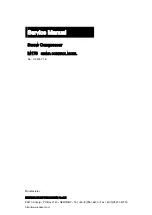
7.1 Subcooler Selection
The use of an economizer is highly recom-
mended and provides the high capacities
and energy efficiencies shown in the screw
compressor tabular rating tables. The sub-
cooling load may be calculated by taking
the total compressor mass flow of the rack
and multiplying it by the change in enthalpy
across the subcooler (liquid main in minus
liquid main out). To estimate the liquid temper-
ature leaving the subcooler, take the saturated
intermediate temperature (at the design
condition) from the performance tables and
add 10°F (5°C). The subcooler should now
be sized based on the subcooling load calcu-
lated. Carlyle recommends sizing and piping
the subcooler for parallel flow. Parallel flow
through the subcooler results in better
control of the subcooler TXV (reduces
TXV hunting).
7.2 Subcooling Correction
The economized performance data supplied is
based on liquid temperature that is 10°F (6°C)
above saturated intermediate temperature. The
capacity may be varied for other than rated liq-
uid temperature by either of two methods. For
the most accurate adjustment, Method #2
should be used.
METHOD 1
Vary compressor capacity by 3% for each
10°F (6°C) difference between actual and
rated liquid temperature. For example, if the
actual liquid temperature was 50°F (10°C)
and the rated liquid temperature was 40°F
(5°C), divide the rated capacity by 1.03.
This method is specifically for R-22.
METHOD 2
Using the mass flow rates published in the
rating tables, a thermodynamic correction
may be used by calculating the new change
in enthalpy across the evaporator and multiply-
ing it by the evaporator mass flow rate.
7.3 Superheat Correction
The screw compressor tabular data is rated
with 65°F (18°C) return gas temperature (all
useful superheat) for low and medium temper-
ature applications. The suction gas does not
pass over the motor, but goes directly to the
compressor rotors. Utilizing R-22 the compres-
sor capacity will have no significant change
Section 7 — Subcooler Selection and Performance Data Adjustment
with lower return gas temperatures based on
all useful superheat at the compressor.
However, the actual
evaporator capacity
will
increase with lower return gas temperature
due to the higher gas density entering the
compressor which will result in larger com-
pressor mass flow rates. Mass flow rates are
published in the compressor performance
tables and may be used to calculate compres-
sor performance at any approved operating
condition. The Carlyle screw compressor
suction gas goes directly into the rotors and
therefore does not incur additional (inefficient)
suction gas superheating from passing over
the motor. There is a required minimum of 20°F
(11°C) discharge superheat. The system
should sound an alarm if the superheat
reaches 20°F (11°C). Long periods of run time
with low discharge superheat will reduce
compressor bearing life.
7.4 Carlyle Software
The Carlyle Compressor Selection program
“CARWIN”
will select compressors, calculate
subcooler load, oil-cooler load, and perform
superheat and subcooling corrections.
This software is available through Carlyle
Compressor Company, at
www.carlylecompressor.com.
The tabular performance data presented in this
catalog is at 65°F(18.3°C) return gas tempera-
ture and SIT+10°F(5.5°C) liquid temperature.
Performance at actual operating conditions
may vary significantly from these rating condi-
tions. Our Carwin selection software can be
used to estimate the performance at the actual
operating conditions.
For systems that have mechanical subcooling,
as with the economizer cycle on our 74mm
compressors, there can be a substantial differ-
ence between the performance at the standard
rating conditions and the applications actual
operating conditions. These differences are
generally only significant in low temperature
applications. For low temperature applications
(SST<0°F/4.4°C), compressor performance
should be based on design liquid temperature
(typically maintained at or above 40°F(4.4°C)
and the maximum return gas temperature
expected (typically 25°F-35°F (-3.8°C-1.7°C)
for low temperature applications). The evapora-
tor refrigeration effect (ERE reported in Carwin)
capacity should then be used to size against
the required load.
30
















































